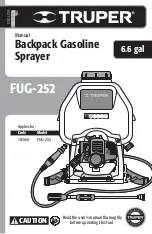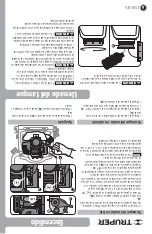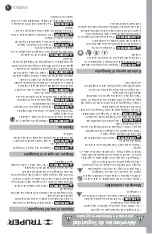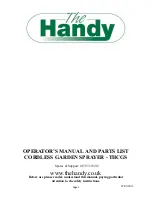
5
ENGLISH
• Keep the sprayer and chemicals
out of the reach of children. Store in a safe place.
• Do not store chemicals in the sprayer tank.
• After preparing the compound it should
be applied immediately.
• Be sure to read and understand the
instructions and precautions for the chemicals to be used
with the equipment before use.
• Be sure to use the specific chemical in
amounts appropriate for the job to be done. Wrong
chemicals and quantities can damage the sprayer, spoil the
sprayed product, cause hazardous situations and serious
ecological damage.
• Even if the chemical is stored in a
plastic container, it may damage some of the equipment
parts. Make sure that the chemical is compatible with high
density polypropylene sprayers.
• Many of the chemicals commonly
used with the sprayer are hazardous if handled or used
incorrectly.
• In case of poisoning, seek medical
advice immediately and show the doctor the label of the
chemical used.
• If the chemical splashes in the mouth or
eyes, wash them out with clean water and then see a
doctor.
• If the operator has a headache or
dizziness, stop work immediately and see a doctor
immediately..
• Always empty and clean the sprayer
after each use.
• Clothes used during application should
be washed daily, separately from everyday clothes.
• Equip yourself with adequate protection:
protective clothing, goggles and respirators with suitable
cartridges so as not to inhale the sprayed chemicals.
• Familiarize yourself with the first aid
procedures described on the chemical container prior to
application.
• For operator safety, spraying must be
carried out strictly in accordance with the chemical
instructions. Spraying extremely poisonous chemicals is
strictly prohibited.
Safety Warnings for
Using Sprayers
• The sprayer is designed for agricultural use.
• Do not attempt to spray hot solutions or solutions that
can become hot with the sprayer.
• Do not attempt to spray gasoline,
flammable liquids, caustic alkalis or corrosive acids
with the sprayer.
Chemicals
Before operating the sprayer
After using the sprayer
• Never leave the sprayer unattended.
• Take care of the sprayer from knocks and falls, especially
when it is pressurized.
• Do not exceed the level indicated on the tank when filling
the sprayer.
• Do not spray while the wind is blowing
or in any other condition that may expose you or others to
the sprayed chemical.
• Do not remove any parts or attempt to make repairs
while the sprayer is pressurized.
• Never carry the sprayer by the hose.
• Do not eat, drink, or smoke while
using the sprayer.
During the use of the sprayer
• Never smoke near the fuel, in the area where the
gasoline is dispensed, or where you prepare the mixture
with the oil, or when operating the sprayer.
• To reduce the risk of fire or burns, handle fuel
carefully, it is highly flammable.
• Do not let gasoline or oil touch your skin.
• Protect your eyes from gasoline and oil splashes. In case
of accidental contact, wash immediately with clean water.
If irritation persists, consult a doctor.
• Mix and store fuel in a container designed for this
purpose.
• Mix fuel outdoors away from any
sparks or flames.
• Before refueling the sprayer turn off the engine, place it
on clear ground and wait for the engine to cool down.
• Clean up any fuel that may have fallen
into the sprayer before operating it.
• Check for fuel leaks and correct them
before using the sprayer to prevent fire or burn injury.
• Move the sprayer at least 30 feet (9 meters) away from
the fueling site before starting the engine.
• Under no circumstances burn spilled fuel for disposal.
• Do not use any type of fuel other than that specified for
the sprayer in these instructions.
Fuel handling
DANGER
CAUTION
CAUTION
CAUTION
CAUTION
CAUTION
CAUTION
CAUTION
CAUTION
CAUTION
CAUTION
CAUTION
WARNING
WARNING
WARNING
WARNING
WARNING
WARNING
WARNING
WARNING
WARNING






































